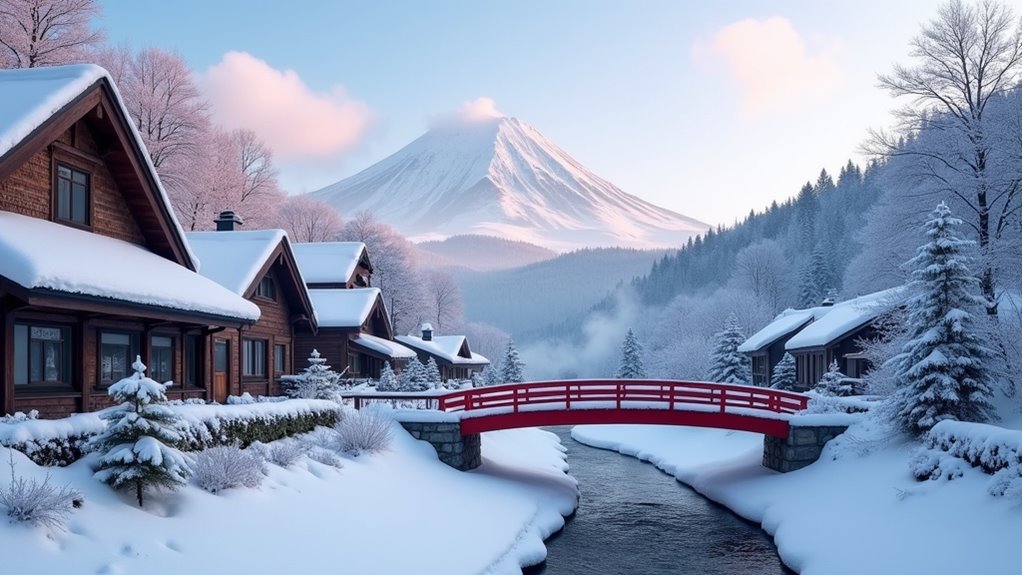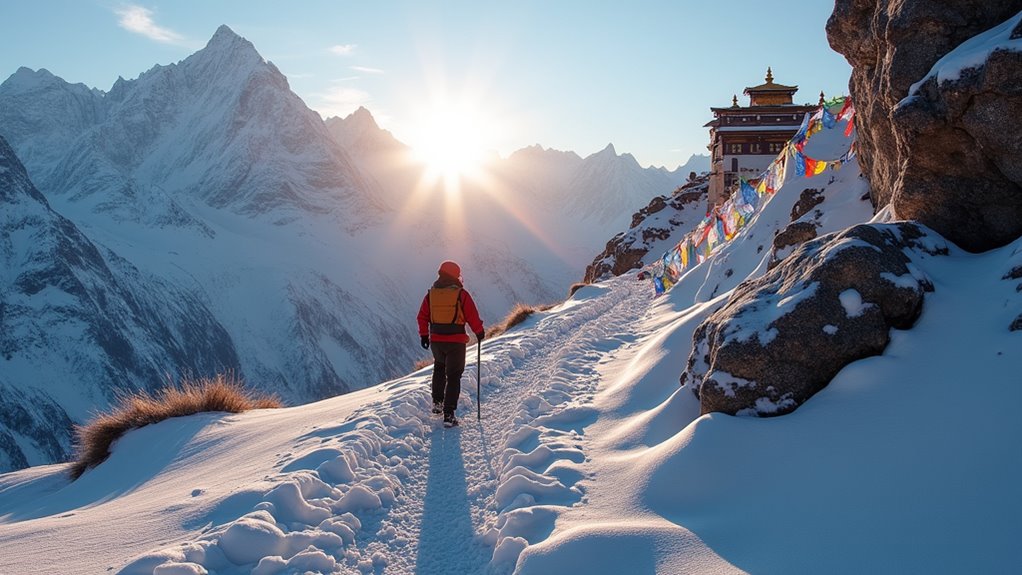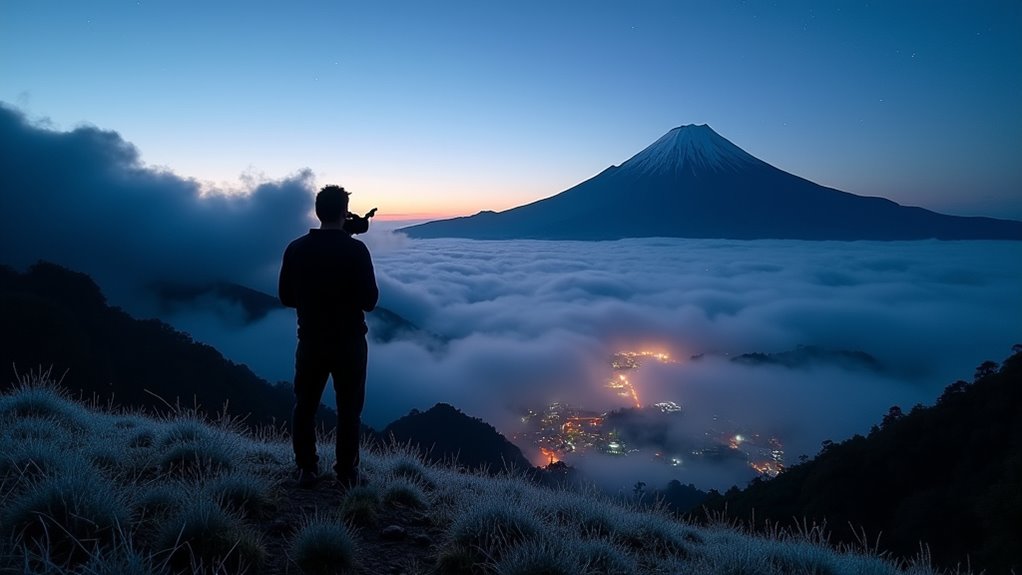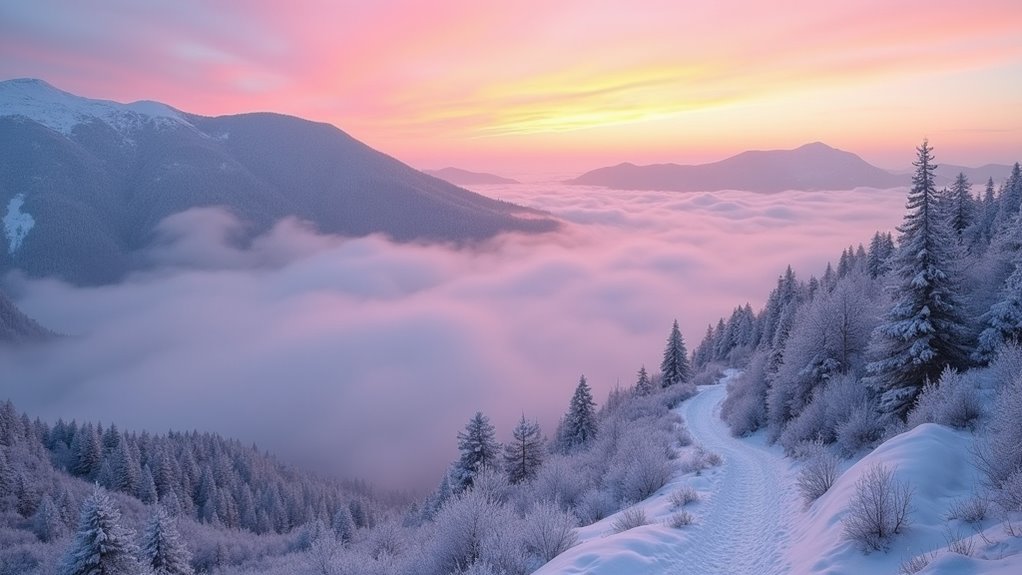Physical Address
304 North Cardinal St.
Dorchester Center, MA 02124
Physical Address
304 North Cardinal St.
Dorchester Center, MA 02124

Shivering temperatures from -40°C to balmy hills await in Asia's coldest destinations, but which one tops this frosty list?
Asia’s coldest destinations span from the Gobi Desert (-40°C winters) to Ladakh’s Himalayan heights (-36°C). You’ll find extreme cold in Northern Japan (down to -41°C), South Korea’s mountains, and Nepal’s highlands. For milder cool spots, consider Dalat (Vietnam), Kundasang (Malaysia), Chiang Rai (Thailand), and Taiwan’s snow-capped peaks. Each location offers unique cultural experiences, stunning landscapes, and respite from tropical heat that goes beyond their temperature readings.

When people imagine deserts, scorching heat typically comes to mind, but Asia’s Gobi Desert defies this expectation by ranking among the world’s coldest desert environments.
Spanning 1.3 million km² across Mongolia and northern China, the Gobi experiences extreme temperature swings that’ll shock you: winter nights plummet to -40°C while summer days soar to 45°C. This expansive region consistently appears on definitive coldest lists across the Asian continent. This high-altitude desert (900-1,500m) receives less than 100mm of annual rainfall, with some regions getting under 50mm.
Straddling two nations, the Gobi’s 85°C temperature range defies expectations—a high-altitude desert where survival means adapting to extremes.
January averages a frigid -21°C, with brutal northwesterly winds creating dangerous conditions. Visitors planning their trips should avoid January through February as these are the coldest months with freezing daytime temperatures and extremely frigid nights. The Gobi’s unique climate creates distinct microclimates, with the Western Gobi experiencing the coldest temperatures.
Despite these harsh conditions, specialized flora and fauna have adapted to survive this unforgiving environment.
Nestled in the formidable Himalayan range, Ladakh stands as one of Asia’s most extreme cold environments, defying India’s chiefly tropical reputation. This high-altitude desert sits in the Himalayan rain shadow at 2,500–4,500m elevation, with average annual temperatures of -6.2°C.
Winter is particularly brutal, with night temperatures plummeting to -36°C in December and January. Even daytime winter averages hover around 2°C, while remote valleys have recorded temperatures below -40°C. The region experiences a temperature range of 30.6°C throughout the year, with January being the coldest month. You’ll experience dramatic daily temperature fluctuations of 20–25°C.
Traditional mud-brick homes with small windows and Bukhari wood stoves help locals survive the harsh climate.
Winter isolation is common as key roads close from November to May. Despite these challenges, tourism flourishes in summer (June-September) and increasingly in winter for the famous Chadar frozen river treks. The area has become one of Asia’s premier outdoor adventure destinations for those seeking pristine natural landscapes in extreme conditions.

Deep in the northernmost reaches of Japan lies a winter wonderland where temperatures regularly plunge to Arctic extremes. Hokkaido and surrounding areas showcase Japan’s coldest climate, with Asahikawa recording the nation’s lowest temperature of -41°C.
You’ll discover a region shaped by its unique geography – from coastal areas pummeled by Sea of Japan snowstorms to sheltered inland valleys like Obihiro that trap frigid air. The region experiences four distinct seasons with dramatically contrasting conditions between winter and summer months. Winter transforms these landscapes into pristine snowscapes that draw visitors worldwide. Unlike tropical destinations like Thailand or Singapore, Northern Japan offers a completely different Asian travel experience with its snow-covered landscapes.
Buildings and infrastructure here are specifically engineered to withstand these extreme conditions, demonstrating Japanese innovation against nature’s challenges.
South Korea’s mountainous terrain dominates the landscape, creating some of Asia’s most striking cold-weather environments. With nearly three-quarters of the country covered by mountains, you’ll find temperatures plummeting to freezing during winter months, especially in the prominent Taebaek and Sobaek ranges.
The country’s highest peaks—Hallasan (1,950m) on Jeju Island, Mount Jiri (1,915m), and Mount Seorak (1,708m)—experience significant seasonal temperature variations. While coastal areas enjoy milder winters around 15°C, the highlands drop to near-freezing conditions.
These granite-dominated mountains aren’t just cold-weather phenomena but ecological treasures. They host diverse ecosystems and draw travelers year-round despite their chilly conditions. Record-breaking temperatures have reached as low as −32.6°C in Yangpyeong during January 1981.
If you’re planning a winter visit, prepare for the stark contrast between South Korea’s warmer coasts and its frosty mountainous interior. Many travelers compare South Korea’s winter experience with Thailand or Philippines when deciding between popular Asian destinations.

The Nepali Highlands rise dramatically from the subtropical lowlands to form one of Asia’s most extreme cold-weather environments. You’ll experience temperatures plummeting below -10°C in winter, with altitudes above 3,600 meters rarely escaping freezing conditions. The highest regions above 16,000 ft (4,877 meters) maintain permanent snow cover throughout the year.
Despite these harsh extremes, these highlands host thriving biodiversity and resilient communities adapted over centuries to the challenging climate. Like its neighbor Laos, Nepal offers stunning landscapes that attract adventure seekers from around the world.
When visiting, you’ll need to prepare for altitude sickness risks and rapidly changing conditions, particularly if you’re trekking through this frigid yet magnificent landscape.
Nestled in Vietnam’s Central Highlands at a significant elevation, Dalat offers visitors an invigorating escape from Southeast Asia’s typical tropical heat. This subtropical highland retreat maintains mild temperatures year-round, ranging from 13°C to 28°C, with January being the coldest month at around 18°C.
You’ll experience distinct wet and dry seasons here, with May through October bringing substantial rainfall—September averages a drenching 297mm. In contrast, February offers drier conditions with just 27mm of precipitation.
The surrounding mountains shield Dalat from weather extremes while creating a picturesque backdrop of lakes, waterfalls, and forests. The region’s unique climate supports diverse flora and fauna, thriving coffee plantations, and flower production. Travelers should remain vigilant during hiking excursions as some of Laos’s deadly wildlife species can be encountered in bordering regions of Southeast Asia.
Beyond natural attractions, you’ll find cultural sites, outdoor activities, and distinctive cuisine that complete this highland getaway. The city is often shrouded in morning fog, creating a mystical atmosphere that has enchanted visitors for generations.

Located at the foot of Malaysia’s tallest peak, Kundasang offers an invigorating highland climate that’s markedly cooler than the country’s tropical lowlands. Unlike the urban experiences of Japanese city alternatives, Kundasang provides a nature-focused retreat for travelers seeking cooler temperatures. At 1,500-1,900 meters elevation, you’ll experience pleasant year-round temperatures averaging 19.7°C (67.5°F), with nighttime lows that require a light jacket—a welcome relief from Malaysia’s typical heat. The area experiences very limited temperature variation throughout the year with only 1.1°C difference between seasons.
The area’s unique microclimate supports tea plantations and cool-weather crops, making it Malaysia’s only perpetual spring-like region.
As Thailand’s northernmost major city, Chiang Rai offers travelers an invigorating escape from the country’s typically sweltering temperatures. Nestled in a mountainous landscape, temperatures here range from a mild 56°F to 94°F, rarely reaching extremes.
You’ll enjoy the most comfortable weather during the dry season (January through March), when clear skies complement the cool mountain air. December stands out as the coldest month with lows reaching 58°F and highs of approximately 80°F. Though not truly cold by global standards, Chiang Rai’s nighttime temperatures can drop to 15°C (59°F) in January, requiring a light jacket.
Beyond its revitalizing climate, the city rewards visitors with stunning cultural landmarks like the White and Blue Temples. Travelers will find that Chiang Rai is one of the more budget-friendly destinations in Southeast Asia compared to more touristy areas.
The region’s affluent Lanna history, hill tribe communities, and distinctive northern Thai cuisine make it worth exploring—all while enjoying a welcome respite from Thailand’s tropical heat.

While Chiang Rai offers relief from Thailand’s tropical heat, Taiwan’s high mountains present a truly surprising cold experience within Asia. When you venture to peaks like Yushan (3,952m) and Xueshan (3,886m), you’ll encounter temperatures that regularly drop below freezing during winter months, with snowfall transforming these tropical island summits into winter wonderlands. The island’s 286 known peaks above 3,000 meters offer numerous opportunities to experience Taiwan’s surprising alpine climate.
For travelers seeking both adventure and unique landscapes, Taiwan’s mountains provide a stark contrast to popular Laotian towns like Vang Vieng, offering natural beauty without the crowds.
Asia’s coldest destinations offer more than just frigid temperatures. You’ll discover diverse landscapes from Vietnam’s cool highlands to Mongolia’s icy expanses where thermometers practically shatter in protest. Whether you’re planning a winter adventure or seeking relief from tropical heat, these nine locations provide unique experiences across the continent. Pack appropriately, respect local conditions, and embrace the remarkable beauty that only exists where Asia’s temperatures plummet.